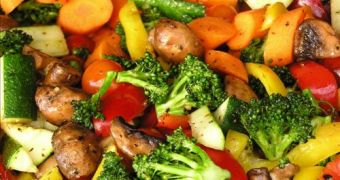The rotation diet is based on introducing in your daily menu various food categories every 4 days. The types of food are divided into four categories and into biological families. Each day you should eat food belonging to the same family or distinct families and groups, but you should not eat that again before four days have passed. For example, if today you eat an apple, during the next four days you must not eat another one or a fruit belonging to its family (Rosaceae, like a pear, cherry, plum, apricot).
The same happens with the food groups: if you eat today a diary product, you must not eat diary products, beef or lamb during the next four days.
This diet stimulates and activates metabolism and the assimilation of the food, favoring liquid loss and increasing energy waste.
The four food groups are:
1.vinegar, mushrooms, beer yeast, bread yeast
2.pork, bacon, salami, sausages, lard
3.milk and diary products, beef, lamb, lactose-containing products
4.eggs, chicken, Guinea fowl
There are some varieties of meat and fish that are an exception: rabbit, horse, turkey, game, brill, swordfish, grouper, hake, trevally, seabass, sea bram.
This is a short guide that enumerates the biological plant food families:
Actinidaceae: kiwi
Anacardiaceae: pistachio, mango
Asteraceae: artichoke, chicory, thistle, lettuce, endive, chamomile, sunflower seeds
Betullaceae: hazelnut
Bromeliaceae: pineapple
Caricaceae: papaya
Chenopodiaceae: sugar beet, red beet, spinach, quinoa
Cruciferae: all types of cabbage, radish, broccoli, cauliflower, turnip, watercress
Cucurbitaceae: water melon, melon, squash, zucchini, cucumber
Fabiaceae: lentils, green and dry broad bean, green and dry bean, soy, white lupine, green and dry peas, chickpea, peanut
Gramineae: oats, rye, sugar cane, bamboo, wheat, corn, malt, millet, rice, barley (and any bread or pasta made of these cereals)
Grossulariaceae: currants
Juglandaceae: wall nut
Labiaceae: basil, marjoram, sage, lavender, lemon balm, mint, oregano, rosemary, thyme
Lauraceae: avocado, cinnamon, laurel
Liliaceae: garlic, asparagus, onion, leek
Moraceae: mulberry
Musaceae: banana
Oleaceae: olive
Polygonaceae: buckwheat
Rosaceae: apricot, cherry, strawberry, raspberry, almond, apple, blackberry, pear, peach, plum, loquat
Rutaceae: orange, pomelo, dancy, lemon
Solanaceae: eggplant, potato, pimiento, tomato
Umbeliferae: anise, carrot, cumin, fennel, parsley, celery, coriander, dill
Urticaceae: nettle
Vitaceae: grapes
The type of menu for four days is:
First day Breakfast: a cup of milk and almonds (Rosaceae), strawberries
11:00 Peach (Rosaceae)
Dinner: Grilled turkey, salad of lettuce with sunflower seeds and five olives; chamomile infusion
17:00 Four apricots
Supper: endive salad with five almonds, macaroni with oven-baked artichokes; one oven-baked apple, chamomile infusion
Second day Breakfast: One banana and yoghurt
11:00 Three slices of watermelon
Dinner: Two pieces of grilled hake; vapor-made zucchini with basil; anise infusion
17:00 Half melon
Supper: Omelette made of 2 eggs with mushrooms; salad of cucumber with yoghurt
Third day Breakfast: One cup of soy milk, one mango
11:00 Grape juice (must), five pistachios
Dinner: Salad made of cabbage, watercress and onion; rabbit cooked with garlic; sage infusion
17:00 Soy shake
Supper: Oven-made seabass, asparagus, lemon balm infusion
Fourth day Breakfast: two pieces of bacon, green tea infusion, one slice of pineapple
11:00 One pomelo
Dinner: Grilled pork loin; boiled spinach with royal quinoa
17:00 One kiwi
Supper: salad of carrots, celery and parsley with half avocado; turkey thigh; half papaya

 14 DAY TRIAL //
14 DAY TRIAL //